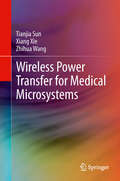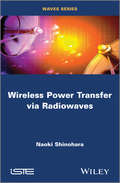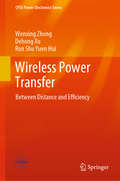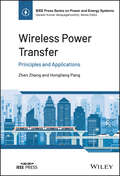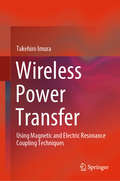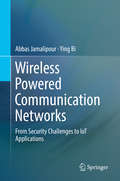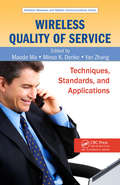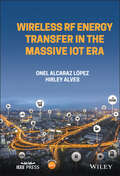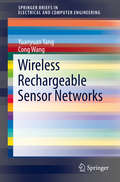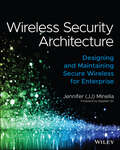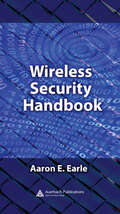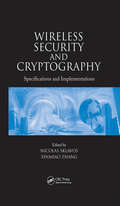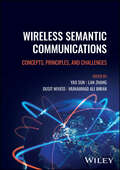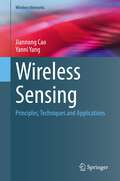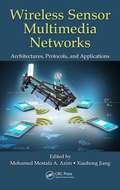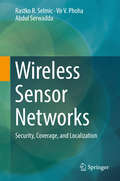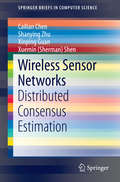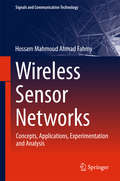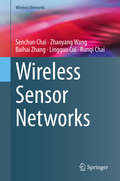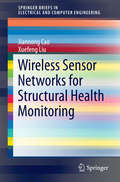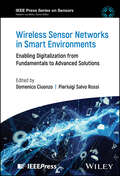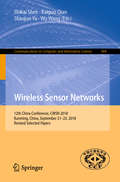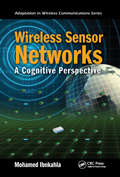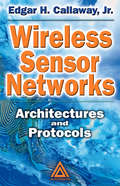- Table View
- List View
Wireless Power Transfer for Medical Microsystems
by Xiang Xie Zhihua Wang Tianjia SunThis book provides an in-depth introduction to the newest technologies for designing wireless power transfer systems for medical applications. The authors present a systematic classification of the various types of wireless power transfer, with a focus on inductive power coupling. Readers will learn to overcome many challenges faced in the design a wirelessly powered implant, such as power transfer efficiency, power stability, and the size of power antennas and circuits. This book focuses exclusively on medical applications of the technology and a batteryless capsule endoscopy system and other, real wirelessly powered systems are used as examples of the techniques described.
Wireless Power Transfer via Radiowaves (Wiley-iste Ser.)
by Naoki ShinoharaRecent advances in Wireless Power Transmission (WPT) technologies have enabled various engineering applications with potential product implementation. WPT can be utilized to charge batteries in various pieces of equipment without the need for a wired connection. Energy can be harvested from ambient RF and microwave radiation and 1 million kW microwaves can be transmitted from space to the ground.This book covers all the theory and technologies of WPT, such as microwave generators with semi-conductors and microwave tubes, antennas, phased arrays, beam efficiency, and rectifiers (rectenna). The authors also discuss coupling WPT. Applications, such as energy harvesting, sensor networks, point-to-point WPT, WPT to moving targets (airplane, vehicle, etc.) and Solar Power Satellite are also presented.
Wireless Power Transfer: Between Distance and Efficiency (CPSS Power Electronics Series)
by Dehong Xu Wenxing Zhong Ron Shu HuiFocusing on inductive wireless power transfer (WPT), which relies on coil resonators and power converters, this book begins by providing the background and basic theories of WPT, which are essential for newcomers to the field. Then two major challenges of WPT – power transfer distance and efficiency – are subsequently addressed, and multi-resonator WPT systems, which not only offer a way to extend power transfer distance but also provide more flexibility, are investigated. Recent findings on techniques to maximize the power transfer efficiency of WPT systems, e.g. maximum efficiency point tracking, are also introduced. Without the constraint of cables, wireless power transfer (WPT) is an elegant technique for charging or powering a range of electrical devices, e.g. electric vehicles, mobile phones, artificial hearts, etc. Given its depth of coverage, the book can serve as a technical guideline or reference guide for engineers and researchers working on WPT.
Wireless Power Transfer: Principles and Applications (IEEE Press Series on Power and Energy Systems)
by Zhen Zhang Hongliang PangWireless Power Transfer Presents a detailed overview of multiple-objective wireless power transfer (WPT) technologies, including the latest research developments and emerging applications Wireless Power Transfer: Principles and Applications offers comprehensive coverage of all key aspects of wireless power transfer (WPT) technologies, including fundamental theory, intelligent control, configuration analysis, and emerging power electronics techniques. This unique resource is the first book of its kind to provide in-depth discussion of energy transmission control schemes with emphasis on omni-directional vector control, energy-encryption-based security control, demand-based optimal designs for transmitter, pickup, and self-resonance coils, multiple-objective power distribution, and maximum efficiency and power control under various conditions. In addition, this text: Presents the methodologies and approaches of emerging multiple-objective WPT technologies Discusses various applications for wireless charging techniques, including contactless power for electric vehicles, in-flight charging for unmanned aerial vehicles, and underwater wireless charging Covers both intermittent and continuous impedance matching methods for different classes of coils Features more than 400 high-quality illustrations and numerous figures and tables throughout Wireless Power Transfer: Principles and Applications is an invaluable technical reference for academic researchers and industry professionals in power and energy engineering, and an excellent textbook for postgraduate courses in relevant areas of industrial and electronic engineering.
Wireless Power Transfer: Using Magnetic and Electric Resonance Coupling Techniques
by Takehiro ImuraThis book describes systematically wireless power transfer technology using magnetic resonant coupling and electric resonant coupling and presents the latest theoretical and phenomenological approaches to its practical implementation, operation and its applications. It also discusses the difference between electromagnetic induction and magnetic resonant coupling, the characteristics of various types of resonant circuit topologies and the unique features of magnetic resonant coupling methods. Designed to be self-contained, this richly illustrated book is a valuable resource for a broad readership, from researchers to engineers and anyone interested in cutting-edge technologies in wireless power transfer.
Wireless Power Transmission for Sustainable Electronics: COST WiPE - IC1301
by Nuno Borges CarvalhoProvides a collection of works produced by COST Action IC1301 with the goal of achieving significant advances in the field of wireless power transmission This book constitutes together information from COST Action IC1301, a group of academic and industry experts seeking to align research efforts in the field of wireless power transmission (WPT). It begins with a discussion of backscatter as a solution for Internet of Things (IoT) devices and goes on to describe ambient backscattering sensors that use FM broadcasting for low cost and low power wireless applications. The book also explores localization of passive RFID tags and augmented tags using nonlinearities of RFID chips. It concludes with a review of methods of electromagnetic characterization of textile materials for the development of wearable antennas. Wireless Power Transmission for Sustainable Electronics: COST WiPE - IC1301 covers textile-supported wireless energy transfer, and reviews methods for the electromagnetic characterization of textile materials for the development of wearable antennas. It also looks at: backscatter RFID sensor systems for remote health monitoring; simultaneous localization (of robots and objects) and mapping (SLAM); autonomous system of wireless power distribution for static and moving nodes of wireless sensor networks; and more. Presents techniques for smart beam-forming for "on demand" wireless power transmission (WPT) Discusses RF and microwave energy harvesting for space applications Describes miniaturized RFID transponders for object identification and sensing Wireless Power Transmission for Sustainable Electronics: COST WiPE - IC1301 is an excellent book for both graduate students and industry engineers involved in wireless communications and power transfer, and sustainable materials for those fields.
Wireless Powered Communication Networks: From Security Challenges to IoT Applications
by Abbas Jamalipour Ying BiThis textbook introduces Wireless Powered Communication Networks (WPCNs) as a promising paradigm to overcome the energy bottleneck suffered by traditional wireless communication networks, as well as emerging Internet-of-Things networks. It selectively spans a coherent spectrum of fundamental aspects in WPCNs, such as wireless energy transfer (WEH) techniques, radio frequency (RF) energy harvesting receiver model, simultaneous wireless information and power transfer (SWIPT), as well as the rate-energy tradeoff arising from the joint transmission of information and energy using the same waveform. It covers network models for WPCNs, including the baseline and dual-hop WPCN models and a variety of related extensions. This book further examines the key factors including throughput, fairness, and security that must be taken into account for impeccable operation of WPCNs. The new IoT applications are targeted as a key element in those factors. It will also include exercises and examples throughout the book, as well as their PLS solutions.This is the first textbook examining the current research to provide a unified view of wireless power transfer (WPT) and information transmission in WPCNs from a physical layer security (PLS) perspective. Focused on designing efficient secure transmission schemes, analyzing energy evolvement process, and evaluating secrecy outage performance under different channel state information (CSI), the results presented in this book shed light on how to best balance security and throughput with prudent use of harvested energy in WCNs. It also provides an overview of the WPCNs by introducing the background of WPT, followed by a summary of the research conducted in the field. The authors describe the physical-layer security (PLS) problem in WPCNs, including the causes and the impacts of the problem on the performance of WPCNs. The authors extend the discussions by introducing the applications of WPCNs in the IoT.From the Internet of Things (IoT) point of view, this textbook reviews the opportunities and challenges for the lately-emerged WPCN to seamlessly integrate into the IoT ecosystem. It specifically addresses the maximization problem of uplink and downlink sum-throughout in a dual-hop WPCN, while taking fairness among WPCN users as a constraint. The results provided in this book reveal valuable insights into improving the design and deployment of future WPCNs in the upcoming IoT environment.This textbook targets advanced-level students studying wireless communications and research engineers working in this field. Industry engineers in mobile device and network development business with an interest in WPCNs and IoT, as well as their PLS solutions, will also find this book useful.
Wireless Quality of Service: Techniques, Standards, and Applications
by Maode Ma Yan Zhang Mieso K. DenkoFocusing on an important and complicated topic in wireless network design, Wireless Quality of Service: Techniques, Standards, and Applications systematically addresses the quality-of-service (QoS) issues found in many types of popular wireless networks.In each chapter, the book presents numerous QoS challenges encountered in real-world
Wireless RF Energy Transfer in the Massive IoT Era: Towards Sustainable Zero-energy Networks (IEEE Press)
by Hirley Alves Onel Alcaraz LopezA deep dive into wireless energy transfer technologies for IoT networks In Wireless Energy Transfer: Towards Sustainable Zero-Energy IoT Networks, distinguished researchers Onel L. A. López and Hirley Alves deliver a robust discussion of massive wireless energy transfer and zero-energy, low-cost, Internet of Things networks. Moving beyond the basic theoretical background of the subject, the authors offer a deep analysis of the scenarios and requirements of wireless energy transfer. The book details novel powering schemes recently proposed to face the challenging requirements of the future Internet of Things, as well as a comprehensive review of sustainable IoT wireless networks. Wireless Energy Transfer explains why novel energy efficient solutions will be needed to address the sheer volume of devices currently forecasted to be used in the near future. It explores the challenges technologists and users will face as well as proposed solutions and future research directions. The authors also discuss: Thorough introductions to wireless energy transfer, including energy harvesting sources, radio frequency energy harvesting circuits, efficiency models, and architectures for wireless energy transfer powered IoT networks Comprehensive explorations of ambient radio frequency energy harvesting, including measurement campaigns, energy harvesting hardware prototypes, and performance analysis based on stochastic geometry Practical discussions of efficient schemes for massive wireless energy transfer, including energy beamforming, multi-antenna techniques, and distributed antenna systems Perfect for students and researchers in signal processing, communications, networking, and information theory, Wireless Energy Transfer: Towards Sustainable Zero-Energy IoT Networks will also earn a place in the libraries of students and practitioners in the fields of communication hardware and transceiver design.
Wireless Rechargeable Sensor Networks
by Cong Wang Yuanyuan YangThis SpringerBrief provides a concise guide to applying wireless energy transfer techniques in traditional battery-powered sensor networks. It examines the benefits and challenges of wireless power including efficiency and reliability. The authors build a wireless rechargeable sensor networks from scratch and aim to provide perpetual network operation. Chapters cover a wide range of topics from the collection of energy information and recharge scheduling to joint design with typical sensing applications such as data gathering. Problems are approached using a natural combination of probability theory, optimization, algorithm and protocol designs. All proposed mechanisms are evaluated by extensive simulations. Wireless Rechargeable Sensor Networks targets professionals and researchers working in networks, wireless communications, energy technology and information technology. Advanced-level students studying electrical engineering and computer science will also find this material useful as a study guide.
Wireless Security Architecture: Designing and Maintaining Secure Wireless for Enterprise
by Jennifer MinellaReduce organizational cybersecurity risk and build comprehensive WiFi, private cellular, and IOT security solutions Wireless Security Architecture: Designing and Maintaining Secure Wireless for Enterprise offers readers an essential guide to planning, designing, and preserving secure wireless infrastructures. It is a blueprint to a resilient and compliant architecture that responds to regulatory requirements, reduces organizational risk, and conforms to industry best practices. This book emphasizes WiFi security, as well as guidance on private cellular and Internet of Things security. Readers will discover how to move beyond isolated technical certifications and vendor training and put together a coherent network that responds to contemporary security risks. It offers up-to-date coverage—including data published for the first time—of new WPA3 security, Wi-Fi 6E, zero-trust frameworks, and other emerging trends. It also includes: Concrete strategies suitable for organizations of all sizes, from large government agencies to small public and private companies Effective technical resources and real-world sample architectures Explorations of the relationships between security, wireless, and network elements Practical planning templates, guides, and real-world case studies demonstrating application of the included conceptsPerfect for network, wireless, and enterprise security architects, Wireless Security Architecture belongs in the libraries of technical leaders in firms of all sizes and in any industry seeking to build a secure wireless network.
Wireless Security Handbook
by Aaron E. EarleThe Wireless Security Handbook provides a well-rounded overview of wireless network security. It examines wireless from multiple perspectives, including those of an auditor, security architect, and hacker. This wide scope benefits anyone who has to administer, secure, hack, or conduct business on a wireless network. This text tackles wirele
Wireless Security and Cryptography: Specifications and Implementations
by Nicolas Sklavos Xinmiao ZhangAs the use of wireless devices becomes widespread, so does the need for strong and secure transport protocols. Even with this intensified need for securing systems, using cryptography does not seem to be a viable solution due to difficulties in implementation. The security layers of many wireless protocols use outdated encryption algorithms, which have proven unsuitable for hardware usage, particularly with handheld devices. Summarizing key issues involved in achieving desirable performance in security implementations, Wireless Security and Cryptography: Specifications and Implementations focuses on alternative integration approaches for wireless communication security. It gives an overview of the current security layer of wireless protocols and presents the performance characteristics of implementations in both software and hardware. This resource also presents efficient and novel methods to execute security schemes in wireless protocols with high performance. It provides the state of the art research trends in implementations of wireless protocol security for current and future wireless communications. Unique in its coverage of specification and implementation concerns that include hardware design techniques, Wireless Security and Cryptography: Specifications and Implementations provides thorough coverage of wireless network security and recent research directions in the field.
Wireless Semantic Communications: Concepts, Principles, and Challenges
by Dusit Niyato Muhammad Ali Imran Lan Zhang Yao SunUnderstand the cutting-edge technology of semantic communications and its growing applications Semantic communications constitute a revolution in wireless technology, combining semantic theory with wireless communication. In a semantic communication, essential information is encoded at the source, drastically reducing the required data usage, and then decoded at the destination in such a way that all key information is recovered, even if transmission is damaged or incomplete. Enhancing the correspondence between background knowledge at source and destination can drive the data usage requirement even lower, producing ultra-efficient information exchanges with ultra-low semantic ambiguity. Wireless Semantic Communications offers a comprehensive overview of this groundbreaking field, its development, and its future application. Beginning with an introduction to semantic communications and its foundational principles, the book then proceeds to cover transceiver design and methods, before discussing use cases and future developments. The result is an indispensable resource for understanding the future of wireless communication. Readers will also find: Analysis of transceiver optimization methods and resource management for semantic communicationDetailed discussion of topics including semantic encoding and decoding, Shannon information theory, and many moreA team of editors with decades of combined experience in the study of wireless communications Wireless Semantic Communications is ideal for electrical and computing engineers and researchers, as well as industry professionals working in wireless communications.
Wireless Sensing: Principles, Techniques and Applications (Wireless Networks)
by Jiannong Cao Yanni YangThis book systematically presents the wireless sensing technology, which has become a promising sensing paradigm in recent years. It includes the introduction of underlying sensing principles, wireless signals, sensing methodologies and enabled applications. Meanwhile, it provides case studies to demonstrate how wireless sensing is applied for representative human and object sensing applications.This book also provides a wireless sensing framework as a guidance to understand and design a wireless sensing system or prototype based on their needs. It also presents a critical investigation of the challenges in achieving wireless sensing in both signal-level and application-level contexts. Accordingly, it summarizes the typical solutions to tackle the related challenges.Researchers and advanced-level students in computer science or electrical engineering working on the design of a wireless system will find this book useful as a reference. Professionals working in the wireless sensing industry will also find this book valuable as a reference tool.
Wireless Sensor Multimedia Networks: Architectures, Protocols, and Applications
by Xiaohong Jiang Mohamed Mostafa A. AzimWireless sensor networks (WSNs) are a special class of ad hoc network in which network nodes composed of tiny sensors pass data such as temperature, pressure, and humidity through the network to a central location. Wireless sensor multimedia networks (WSMNs) are a special category of WSNs in which the sensor nodes are small cameras and microphones
Wireless Sensor Networks
by Vir V. Phoha Rastko R. Selmic Abdul SerwaddaThis book presents a comprehensive overview of wireless sensor networks (WSNs) with an emphasis on security, coverage, and localization. It offers a structural treatment of WSN building blocks including hardware and protocol architectures and also provides a systems-level view of how WSNs operate. These building blocks will allow readers to program specialized applications and conduct research in advanced topics. A brief introductory chapter covers common applications and communication protocols for WSNs. Next, the authors review basic mathematical models such as Voroni diagrams and Delaunay triangulations. Sensor principles, hardware structure, and medium access protocols are examined. Security challenges ranging from defense strategies to network robustness are explored, along with quality of service measures. Finally, this book discusses recent developments and future directions in WSN platforms. Each chapter concludes with classroom-tested exercises that reinforce key concepts. This book is suitable for researchers and for practitioners in industry. Advanced-level students in electrical engineering and computer science will also find the content helpful as a textbook or reference.
Wireless Sensor Networks
by Xuemin Sherman Shen Cailian Chen Shanying Zhu Xinping GuanThis SpringerBrief evaluates the cooperative effort of sensor nodes to accomplish high-level tasks with sensing, data processing and communication. The metrics of network-wide convergence, unbiasedness, consistency and optimality are discussed through network topology, distributed estimation algorithms and consensus strategy. Systematic analysis reveals that proper deployment of sensor nodes and a small number of low-cost relays (without sensing function) can speed up the information fusion and thus improve the estimation capability of wireless sensor networks (WSNs). This brief also investigates the spatial distribution of sensor nodes and basic scalable estimation algorithms, the consensus-based estimation capability for a class of relay assisted sensor networks with asymmetric communication topology, and the problem of filter design for mobile target tracking over WSNs. From the system perspective, the network topology is closely related to the capability and efficiency of network-wide scalable distributed estimation. Wireless Sensor Networks: Distributed Consensus Estimation is a valuable resource for researchers and professionals working in wireless communications, networks and distributed computing. Advanced-level students studying computer science and electrical engineering will also find the content helpful.
Wireless Sensor Networks
by Hossam Mahmoud Ahmad FahmyThisbook focuses on the principles of wireless sensor networks (WSNs), theirapplications, and their analysis tools, with meticulous attention paid todefinitions and terminology. This book presents the adopted technologies andtheir manufacturers in detail, making WSNs tangible for the reader. Inintroductory computer networking books, chapter sequencing follows thebottom-up or top-down architecture of the 7-layer protocol. This bookaddresses subsequent steps in this process, both horizontally and vertically,thus fostering a clearer and deeper understanding through chapters thatelaborate on WSN concepts and issues. With such depth, this book is intended for a wide audience; it ismeant to be a helper and motivator for senior undergraduates, postgraduates,researchers, and practitioners. It lays out important concepts and WSN-relateapplications; uses appropriate literature to back research and practicalissues; and focuses on new trends. Senior undergraduate students can use it tofamiliarize themselves with conceptual foundations and practical projectimplementations. For graduate students and researchers, test beds andsimulators provide vital insights into analysis methods and tools for WSNs. Lastly, in addition to applications and deployment, practitioners will be ableto learn more about WSN manufacturers and components within several platformsand test beds.
Wireless Sensor Networks (Wireless Networks)
by Runqi Chai Senchun Chai Zhaoyang Wang Baihai Zhang Lingguo CuiThis book presents state-of-the-art research advances in the field of wireless sensor networks systems and approaches. It provides in-depth study on a number of major topics such as protocols, localization, coverage control, community detection, small world analysis, etc. Multidisciplinary in nature and closely integrating theory and practice, the book will be of interest to all university researchers, telecommunications engineers and graduate students in wireless sensor networks who wish to learn the core principles, methods, algorithms, and applications. It would help readers rapidly grasp major topics of wireless sensor network and their advances.
Wireless Sensor Networks for Structural Health Monitoring
by Jiannong Cao Xuefeng LiuThis brief covers the emerging area of wireless sensor network (WSN)-based structural health monitoring (SHM) systems, and introduces the authors' WSN-based platform called SenetSHM. It helps the reader differentiate specific requirements of SHM applications from other traditional WSN applications, and demonstrates how these requirements are addressed by using a series of systematic approaches. The brief serves as a practical guide, explaining both the state-of-the-art technologies in domain-specific applications of WSNs, as well as the methodologies used to address the specific requirements for a WSN application. In particular, the brief offers instruction for problem formulation and problem solving based on the authors' own experiences implementing SenetSHM. Seven concise chapters cover the development of hardware and software design of SenetSHM, as well as in-field experiments conducted while testing the platform. The brief's exploration of the SenetSHM platform is a valuable feature for civil engineers designing their own similar SHM products, and the various concrete examples of problem formulation and algorithm design will make this an essential read for practitioners, researchers and students alike.
Wireless Sensor Networks in Smart Environments: Enabling Digitalization from Fundamentals to Advanced Solutions (IEEE Press Series on Sensors)
by Domenico Ciuonzo Pierluigi Salvo RossiUnderstand the fundamental building blocks of the Internet of Things The Internet of Things is the term for an ever-growing body of physical devices, vehicles, rooms, and other objects that can collect and exchange data using embedded capacities for network connectivity. Wireless Sensor Networks (WSNs) represent the ‘sensing arm’ of this network of objects, providing the mechanism for collecting and transmitting data from these objects. Wireless Sensor Networks in Smart Environments offers a timely and comprehensive overview of these networks and their broader impacts. Adopting both methodology- and application-oriented perspectives, the book covers both the foundational principles of WSNs and the most recent technological developments. Readers will also find: Concrete real-world examples of recent applicationsDetailed discussion of WSNs from the perspectives of signal processing, data communication, and securityCoverage of inference, learning, control, and decision-making processes Wireless Sensor Networks in Smart Environments is ideal for researchers and graduate students working in signal processing, communications, and machine learning.
Wireless Sensor Networks: 12th China Conference, Cwsn 2018 Kunming, China, September 21-23, 2018, Revised Selected Papers (Communications in Computer and Information Science #984)
by Shikai Shen Kaiguo Qian Shaojun Yu Wu WangThis book constitutes the refereed proceedings of the 12th China Conference on Wireless Sensor Networks, CWSN 2018, held in Kunming, China, in September 2018. <P><P> The 16 revised full papers were carefully reviewed and selected from 177 submissions. The papers are organized in topical sections on algorithm for wireless sensor network; positioning and location; neural network; energy efficiency and harvesting; privacy and security; image processing.
Wireless Sensor Networks: A Cognitive Perspective (Adaptation in Wireless Communications #3)
by Mohamed IbnkahlaWith classical techniques for data transmission soon reaching their limitations, cognitive approaches may offer a solution to user requirements for better coverage, connectivity, security, and energy efficiency at lower cost. Wireless Sensor Networks: A Cognitive Perspective presents a unified view of the state of the art of cognitive approaches in telecommunications. A benchmark in the field, it brings together research that has previously been scattered throughout conference and journal papers. Cutting-Edge Topics in Cognitive Communications After a review of the cognitive concept and approaches, the book outlines a generic architecture for cognition in wireless sensor networks. It then targets specific issues that need to be addressed through cognition, from cognitive radio and spectrum access to routing protocols. The book also explores how to use weighted cognitive maps to improve network lifetime through optimizing routing, medium access, and power control while fulfilling end-to-end goals. The final chapter discusses the implementation of hardware for GPS/INS-enabled wireless sensor networks. This addresses an important need for real-time node position information in many wireless sensor network applications and communication protocols. Real-World Applications of Wireless Sensor Networks using the Cognitive Concept Written in a tutorial style, the book supplies an in-depth survey of each topic, accompanied by detailed descriptions of the algorithms and protocols. It also provides a step-by-step analysis of the various communications systems through extensive computer simulations and illustrations. Examples cover environmental monitoring, vehicular communications, tracking, and more. A comprehensive overview of cognitive communications in wireless sensor networks, this work lays the foundations for readers to participate in a new era of research in this emerging field.
Wireless Sensor Networks: Architectures and Protocols (Internet And Communications)
by Edgar Callaway Jr.Because they provide practical machine-to-machine communication at a very low cost, the popularity of wireless sensor networks is expected to skyrocket in the next few years, duplicating the recent explosion of wireless LANs. Wireless Sensor Networks: Architectures and Protocols describes how to build these networks.
